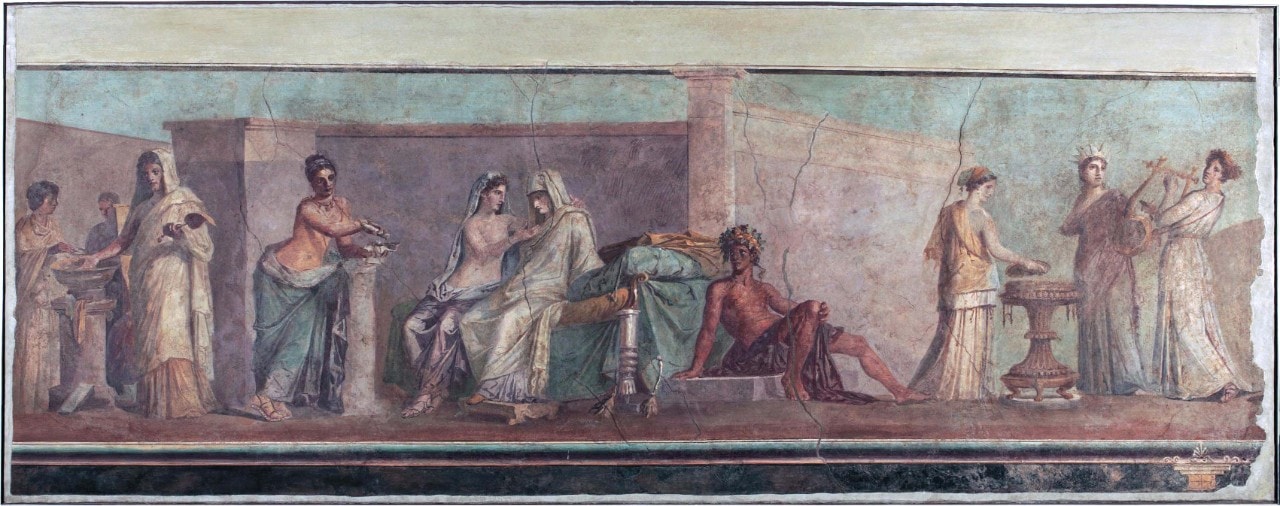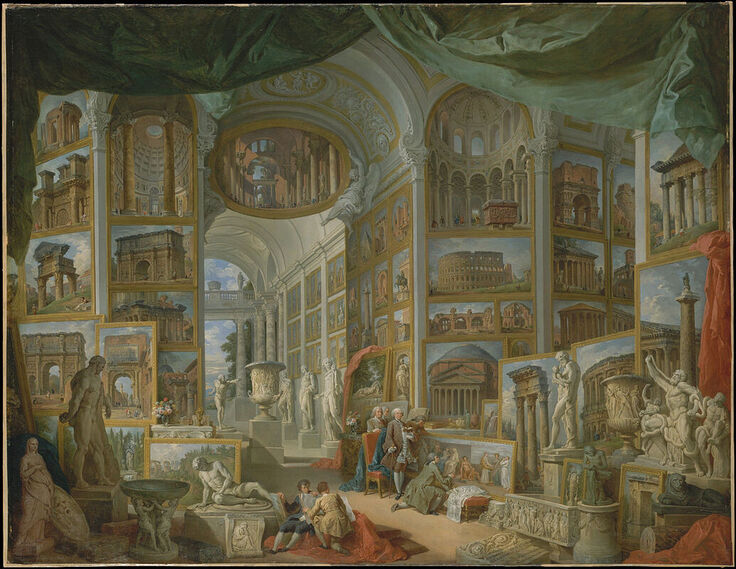|
Where? Room of the Aldobrandini Wedding in the Vatican Museums
When? The first century B.C. What do you see? The painting is divided into three scenes taking place in three separate areas divided by walls.
Alternative interpretations: The meaning of this fresco is subject to a lot of debate and there is serious doubt on whether this is indeed a wedding scene as its title suggests. One alternative interpretation put forward by Frank Müller in 1994 is that the fresco shows a scene from Hippolytus Stephanephoros, a tragedy written by Euripides around 428 B.C. According to Müller's interpretation, the woman dressed in white is Phaedra, a princess from Crete. She was in love with Hippolytus, the man to the right of her. Phaedra is full of guilt as she is married to Theseus (who is the father of Hippolytus). Aphrodite comforts Phaedra. To the left of Aphrodite is her daughter Peitho. On the left is a tablet standing against a pillar containing a love declaration from Phaedra. The two people on the left perform magic spells to win over Hippolytus for Phaedra as Hippolytus is not interested in her yet. On the right is Artemis, who protects Hippolytus, surrounded by two of her nymphs. This interpretation is not without problems, but one argument in favor of it is that other frescos created around the same time often show mythological stories of tragic wives. Backstory: This fresco is from the first century B.C. It is part of a larger fresco, probably a frieze near the ceiling in a retiring room in an Ancient Roman house. The fresco was discovered around 1601 in the remains of an ancient house on the Esquiline Hill (one of the seven hills on which Rome is built). Cardinal Cinzio Passeri Aldobrandini (1551-1610) came in possession of this fresco, explaining the name of the fresco, and it stayed within his family until 1818. In that year, Pope Pius VII bought the fresco from the Aldobrandini family and in 1838 it was placed on display on its current spot in the Vatican Museums. Replicas: Before the 19th century, this was one of the few Ancient Roman frescos that were rediscovered. This fresco inspired many artists to copy it, including Poussin, Rubens, Van Dyck. In 1674, Pietro Santi Bartoli created a beautiful watercolor replica of the Aldobrandini Wedding. The fresco is also featured in Giovanni Paolo Panini’s painting Ancient Rome which is on display in the Metropolitan Museum of Art, the Louvre, and the Staatsgalerie in Stuttgart.
Fun fact: The discussion about what this painting represents is still ongoing. The traditional interpretation that this fresco shows a wedding scene has been countered by various mythological interpretations. These interpretations look carefully at each attribute in the painting to understand who the different figures represent.
However, one simple argument against interpreting this fresco as a wedding is that none of the people looks even remotely happy. Especially the supposed wedding couple looks far from happy. While one may argue that the preparations for a wedding are stressful, that would still leave the question why someone would like to have a wedding scene with such serious and concerned faces on his or her wall.
Written by Eelco Kappe
References:
0 Comments
Leave a Reply. |
Categories
All
|
- Home
- Blog
-
Museums
- Alte Pinakothek
- Art Institute of Chicago
- Baltimore Museum of Art
- Barber Institute of Fine Arts
- Bargello
- Barnes Foundation
- British Museum
- Church of Sant’Anastasia
- Cleveland Museum of Art
- Courtauld Institute of Art
- Detroit Institute of Arts
- Frans Hals Museum
- Galleria Borghese
- Gallerie dell'Accademia
- Getty Museum
- Guggenheim
- Hermitage Museum
- Kunsthistorisches Museum
- Kunstmuseum Basel
- Legion of Honor Museum
- Louvre
- Mauritshuis
- Metropolitan Museum of Art
- Musee d’Orsay
- Museum of Fine Arts in Boston
- Museum of Modern Art
- National Gallery in London
- National Gallery of Art
- National Museum in Poznań
- Norton Simon Museum
- Ny Carlsberg Glyptotek
- Palace of Versailles
- Palazzo Pitti
- Palazzo Vecchio
- Petit Palais
- Philadelphia Museum of Art
- Prado
- Pushkin Museum
- Ravenna Art Museum
- Rijksmuseum
- San Diego Museum of Art
- Santa Maria delle Grazie
- St. Peter's Basilica
- Städel Museum
- Statens Museum for Kunst
- Tate Britain
- Tate Modern
- Timken Museum of Art
- Uffizi
- Vatican Museums
- Wallace Collection
-
Artists
- Altdorfer
- Anguissola
- Berlin Painter
- Bosch
- Botticelli
- Boucher
- Bronzino
- Bruegel the Elder
- Brunelleschi
- Cabanel
- Caillebotte
- Canova
- Caravaggio
- Carpeaux
- Cezanne
- Cimabue
- David
- Degas
- Delacroix
- De Maria
- Donatello
- El Greco
- Fontana
- Fra Angelico
- Fragonard
- Gauguin
- Gentileschi
- Gericault
- Gonzalez-Torres
- Goya
- Hals
- Hogarth
- Hokusai
- Ingres
- Leonardo da Vinci
- Lippi, Filippo
- Longhi, Barbara
- Lorrain
- Makovsky
- Manet
- Massys
- Matisse
- Merian
- Michelangelo
- Mochi
- Modigliani
- Monet
- Panini
- Parmigianino
- Perugino
- Picasso
- Pisanello
- Raphael
- Rembrandt
- Renoir
- Reynolds
- Rivera
- Rodin
- Rubens
- Scultori
- Seurat
- Steen
- Tintoretto
- Titian
- Toulouse-Lautrec
- Turner
- Uccello
- Van der Weyden
- Van Dyck
- Van Eyck
- Van Gogh
- Van Hemessen
- Vasari
- Velazquez
- Vermeer
- Veronese
- Vigée Le Brun
-
Locations
- Books
- About Us



